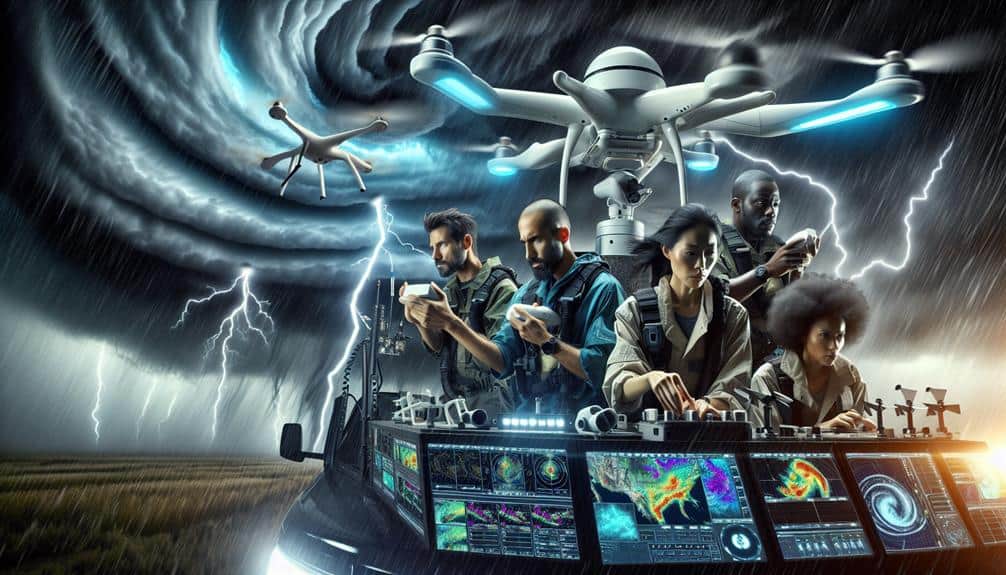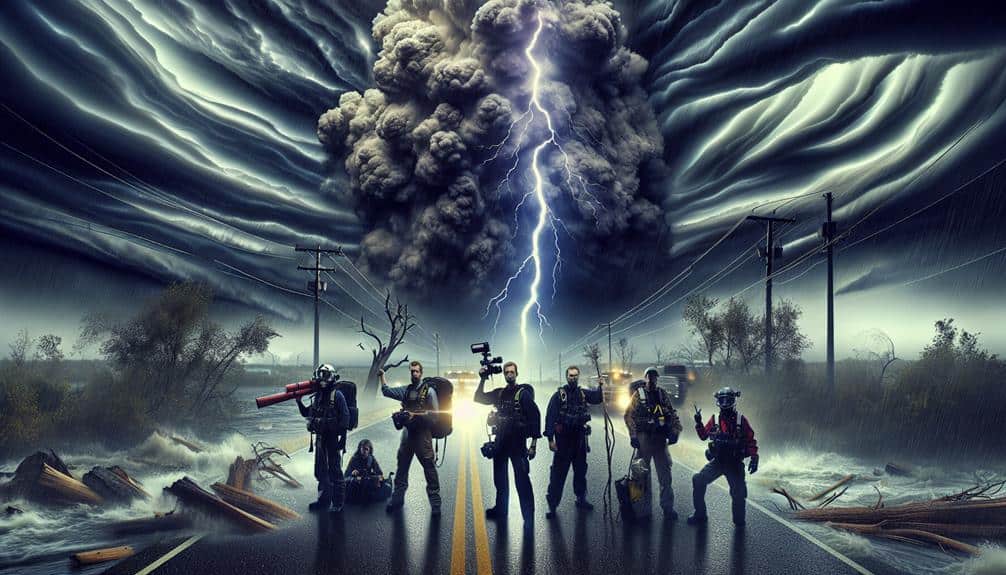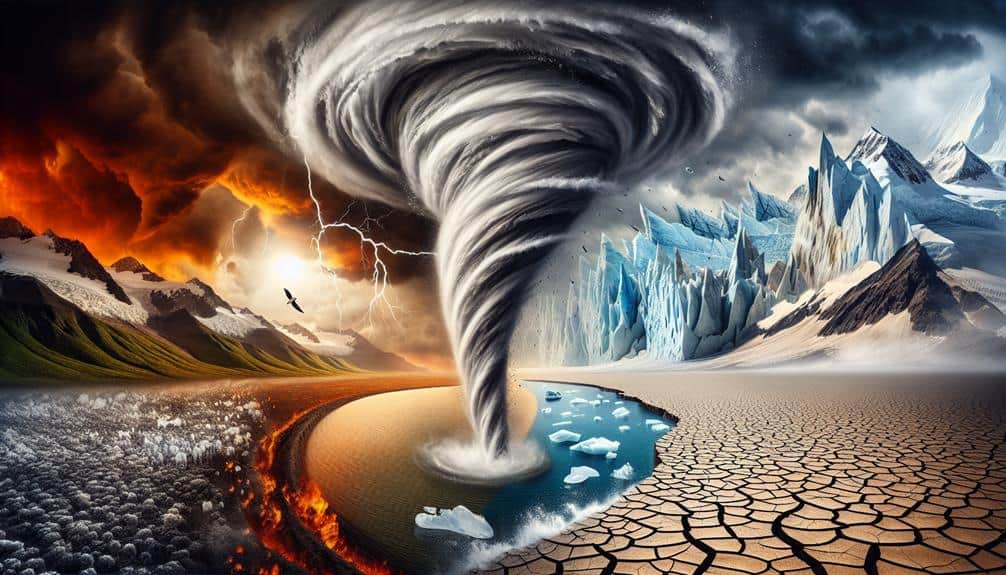We're facing significant challenges as climate change intensifies storms by 30%, making our efforts both riskier and more crucial. Unpredictable weather patterns disrupt our predictive models, requiring advanced real-time analytics and machine learning for accurate forecasting. Extended storm seasons demand better equipment and higher budgets for fuel, food, and lodging, while increasing our environmental footprint. Safety concerns escalate, necessitating strict protocols and reliable GPS tracking. Technological upgrades, like high-definition satellite imagery and mobile data collection units, are essential for capturing precise data. These hurdles reshape our strategies, pushing us to adapt and innovate continuously. Stay with us to discover our evolving methods.
Key Points
- Increased storm intensity requires advanced equipment to handle Category 4 and 5 hurricanes.
- Unpredictable weather patterns necessitate real-time data analytics and machine learning for improved forecasting.
- Extended storm seasons demand higher budgets for equipment, fuel, and lodging, along with greener alternatives.
- Heightened safety risks call for strict protocols, real-time GPS tracking, and data-driven emergency procedures.
Increased Storm Intensity
As climate change accelerates, data shows a marked increase in the intensity of storms, posing greater challenges for storm chasers. The National Oceanic and Atmospheric Administration (NOAA) reports a 30% rise in Category 4 and 5 hurricanes over the past two decades. This escalation in storm intensity directly correlates with greater storm damage, impacting both urban and rural areas alike.
As storm chasers, we must navigate these increasingly hazardous conditions while collecting essential meteorological data.
Increased storm intensity also complicates emergency response efforts. According to the Federal Emergency Management Agency (FEMA), response times are delayed by up to 15% in areas experiencing severe storm damage. This delay can be crucial, as it hampers timely aid and recovery operations.
As storm chasers, we often find ourselves first on the scene, providing real-time data vital for emergency response teams. Our role becomes even more indispensable as we document the extent of storm damage, enabling authorities to allocate resources more effectively.
Thus, while the thrill of storm chasing remains, the stakes have never been higher. We must adapt to these intensified conditions, ensuring our data supports rapid, efficient emergency response and minimizes the impact of storm damage on affected communities.
Unpredictable Weather Patterns
Unforeseeable weather patterns driven by climate change introduce significant challenges for storm chasers, complicating both forecasting and data collection efforts. As storm chasers, we rely on precise weather forecasting to position ourselves strategically, but increased variability in atmospheric conditions undermines our predictive models. Traditional algorithms, calibrated to historical weather data, often fall short in the face of these new, erratic patterns.
Climate adaptation becomes essential as we update our methodologies to tackle this unpredictability. Integrating real-time data analytics and machine learning can enhance our predictive capabilities, but these technologies require continuous refinement and substantial computational resources. Additionally, the sheer increase in data volume necessitates advanced processing techniques to sift through relevant meteorological inputs quickly.
Our freedom in chasing storms hinges on our ability to anticipate their behavior accurately. Unforeseeable weather disrupts this autonomy, forcing us to adapt rapidly or risk missing critical data collection opportunities.
Moreover, this unpredictability can lead to heightened safety risks, as sudden shifts in storm paths or intensities may catch us off guard. As a result, a robust climate adaptation strategy, incorporating cutting-edge weather forecasting technologies, is essential for maintaining both our operational effectiveness and safety in the field.
Extended Storm Seasons
Extended storm seasons, driven by climate change, require a reevaluation of our operational timelines and resource allocations to maintain continuous and effective storm chasing efforts. We observe that the traditional storm chasing periods are extending, necessitating prolonged engagement. This shift impacts our logistical planning, calling for more robust equipment upgrades and more conscientious resource management.
To navigate these extended seasons effectively, we must consider several key factors:
- Equipment upgrades: Enhanced technology is crucial for tracking storms over longer periods, necessitating investments in more durable and advanced equipment.
- Resource allocation: Prolonged seasons demand increased fuel, food, and lodging budgets to sustain operations over extended periods.
- Environmental impact: More active chasing periods contribute to a larger carbon footprint, prompting us to find greener alternatives and more efficient travel routes.
- Data analysis: Extended seasons provide more data, requiring advanced analytics and storage solutions to process and interpret the increased information.
Safety Concerns for Chasers
Managing the increasing volatility of storm patterns demands that we implement strict safety protocols to protect our team in the field. With climate change escalating the intensity and unpredictability of storms, our first line of defense lies in thorough equipment maintenance. We regularly calibrate our radar systems and optimize our vehicles to handle extreme weather conditions. This includes checking tire treads, engine performance, and communication devices to prevent failures in key moments.
Furthermore, our emergency procedures have evolved to match the heightened risks. We conduct regular drills to guarantee everyone knows the evacuation routes, rendezvous points, and emergency contact protocols. GPS tracking systems are essential, allowing us to monitor each team member's location in real-time. These measures are data-driven, based on past incident analyses and predictive models, which highlight areas of potential risk.
In this high-stakes environment, precision and preparedness are essential. By focusing on robust equipment maintenance and clearly defined emergency procedures, we aim to mitigate the inherent dangers of storm chasing. Our commitment to safety not only preserves our operational freedom but also ensures we can continue to gather vital data without compromising our well-being.
Technological Adaptations Needed

Our team must leverage cutting-edge technology to adapt to the increased volatility and severity of storms driven by climate change. The unpredictability of storm patterns requires significant equipment upgrades and advancements in data analysis techniques. By integrating the latest technologies, we can enhance our predictive capabilities and safety measures.
To address these challenges, we need to focus on several key technological adaptations:
- Upgraded radar systems: Advanced Doppler radar systems provide higher resolution data, enabling more precise storm tracking and better real-time updates.
- High-definition satellite imagery: Utilizing satellites with improved resolution allows us to monitor storm development and progression with greater accuracy.
- Mobile data collection units: Equipping our vehicles with state-of-the-art sensors and communication tools guarantees we capture critical data from the storm's core.
- Machine learning algorithms: Implementing AI-driven models helps us analyze vast datasets quickly, identifying patterns and predicting storm behavior more effectively.
These technological advancements not only improve our operational efficiency but also enhance our ability to gather essential data, contributing to broader climate change research. By embracing these innovations, we're better equipped to navigate the evolving challenges posed by climate change while maintaining the freedom we cherish in our storm-chasing endeavors.
Frequently Asked Questions
How Do Storm Chasers Contribute to Climate Change Research?
We collect vital data on storm patterns, feeding real-time information into climate models. By collaborating with research institutions, we enhance predictive accuracy, empowering scientists and ensuring freedom to adapt strategies in the face of climate change.
What Qualifications Are Needed to Become a Storm Chaser?
To become storm chasers, we need strong educational requirements and experience in meteorology. We should complete training programs and obtain certifications available. These qualifications guarantee we can effectively and safely track storms, contributing valuable data to climate research.
How Does Climate Change Affect Storm Chasers' Mental Health?
We can't ignore the mental health impacts climate change has on us. The unpredictability and intensity of storms test our emotional resilience daily. Data shows increased anxiety and stress levels among storm chasers, affecting overall well-being.
Are There Any Legal Restrictions for Storm Chasing Activities?
We face legal restrictions and safety concerns while storm chasing. Regulations often mandate safe distances from tornadoes and hurricanes. Data shows these measures aim to minimize risks, but they can limit our freedom to capture critical weather data.
How Is the Storm Chasing Community Adapting to These New Challenges?
In the eye of the storm, we're adapting by enhancing safety measures and leveraging technology advancements. Improved forecasting accuracy and refined communication strategies are essential for us to navigate these challenges efficiently and continue our pursuit of freedom.


